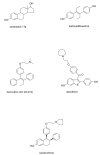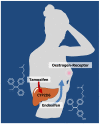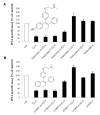The St. Gallen Prize Lecture 2011: evolution of long-term adjuvant anti-hormone therapy: consequences and opportunities
- PMID: 22015273
- PMCID: PMC3521565
- DOI: 10.1016/S0960-9776(11)70287-9
The St. Gallen Prize Lecture 2011: evolution of long-term adjuvant anti-hormone therapy: consequences and opportunities
Abstract
The successful translation of the scientific principles of targeting the breast tumour oestrogen receptor (ER) with the nonsteroidal anti-oestrogen tamoxifen and using extended durations (at least 5 years) of adjuvant therapy, dramatically increased patient survivorship and significantly enhanced a drop in national mortality rates from breast cancer. The principles are the same for the validation of aromatase inhibitors to treat post-menopausal patients but tamoxifen remains a cheap, life-saving medicine for the pre-menopausal patient. Results from the Oxford Overview Analysis illustrate the scientific principle of "longer is better" for adjuvant therapy in pre-menopausal patients. One year of adjuvant therapy is ineffective at preventing disease recurrence or reducing mortality, whereas five years of adjuvant tamoxifen reduces recurrence by 50% which is maintained for a further ten years after treatment stops. Mortality is reduced but the magnitude continues to increase to 30% over a 15-year period. With this clinical database, it is now possible to implement simple solutions to enhance survivorship. Compliance with long-term anti-hormone adjuvant therapy is critical. In this regard, the use of selective serotonin reuptake inhibitors (SSRIs) to reduce severe menopausal side effects may be inappropriate. It is known that SSRIs block the CYP2D6 enzyme that metabolically activates tamoxifen to its potent anti-oestrogenic metabolite, endoxifen. The selective norepinephrine reuptake inhibitor, venlafaxine, does not block CYP2D6, and may be a better choice. Nevertheless, even with perfect compliance, the relentless drive of the breast cancer cell to acquire resistance to therapy persists. The clinical application of long-term anti-hormonal therapy for the early treatment and prevention of breast cancer, focused laboratory research on the discovery of mechanisms involved in acquired anti-hormone resistance. Decades of laboratory study to reproduce clinical experience described not only the unique mechanism of selective ER modulator (SERM)-stimulated breast cancer growth, but also a new apoptotic biology of oestradiol action in breast cancer, following 5 years of anti-hormonal treatment. Oestradiol-induced apoptotic therapy is currently shown to be successful for the short-term treatment of metastatic ER positive breast cancer following exhaustive treatment with anti-hormones. The "oestrogen purge" concept is now being integrated into trials of long-term adjuvant anti-hormone therapy. The Study of Letrazole Extension (SOLE) trial employs "anti-hormonal drug holidays" so that a woman's own oestrogen may periodically purge and kill the nascent sensitized breast cancer cells that are developing. This is the translation of an idea first proposed at the 1992 St. Gallen Conference. Although tamoxifen is the first successful targeted therapy in cancer, the pioneering medicine is more than that. A study of the pharmacology of tamoxifen opened the door for a pioneering application in cancer chemoprevention and created a new drug group: the SERMs, with group members (raloxifene and lasofoxifene) approved for the treatment and prevention of osteoporosis with a simultaneous reduction of breast cancer risk. Thus, the combined strategies of long-term anti-hormone adjuvant therapy, targeted to the breast tumour ER, coupled with the expanding use of SERMs to prevent osteoporosis and prevent breast cancer as a beneficial side effect, have advanced patient survivorship significantly and promise to reduce breast cancer incidence.
Copyright © 2011 Elsevier Ltd. All rights reserved.
Figures










Similar articles
-
Where do selective estrogen receptor modulators (SERMs) and aromatase inhibitors (AIs) now fit into breast cancer treatment algorithms?J Steroid Biochem Mol Biol. 2001 Dec;79(1-5):227-37. doi: 10.1016/s0960-0760(01)00140-6. J Steroid Biochem Mol Biol. 2001. PMID: 11850229 Review.
-
Development and evolution of therapies targeted to the estrogen receptor for the treatment and prevention of breast cancer.Steroids. 2007 Jan;72(1):7-25. doi: 10.1016/j.steroids.2006.10.009. Epub 2006 Dec 13. Steroids. 2007. PMID: 17169390 Free PMC article. Review.
-
Sex steroid induced apoptosis as a rational strategy to treat anti-hormone resistant breast and prostate cancer.Discov Med. 2016 May;21(117):411-27. Discov Med. 2016. PMID: 27355337
-
Effects of chemotherapy and hormonal therapy for early breast cancer on recurrence and 15-year survival: an overview of the randomised trials.Lancet. 2005 May 14-20;365(9472):1687-717. doi: 10.1016/S0140-6736(05)66544-0. Lancet. 2005. PMID: 15894097
-
Treatment of lymph-node-negative, oestrogen-receptor-positive breast cancer: long-term findings from National Surgical Adjuvant Breast and Bowel Project randomised clinical trials.Lancet. 2004 Sep 4-10;364(9437):858-68. doi: 10.1016/S0140-6736(04)16981-X. Lancet. 2004. PMID: 15351193 Clinical Trial.
Cited by
-
The Wnt signalling pathway is upregulated in an in vitro model of acquired tamoxifen resistant breast cancer.BMC Cancer. 2013 Apr 2;13:174. doi: 10.1186/1471-2407-13-174. BMC Cancer. 2013. PMID: 23547709 Free PMC article.
-
Pharmacological relevance of endoxifen in a laboratory simulation of breast cancer in postmenopausal patients.J Natl Cancer Inst. 2014 Sep 24;106(10):dju283. doi: 10.1093/jnci/dju283. Print 2014 Oct. J Natl Cancer Inst. 2014. PMID: 25258390 Free PMC article.
-
Minireview: The androgen receptor in breast tissues: growth inhibitor, tumor suppressor, oncogene?Mol Endocrinol. 2012 Aug;26(8):1252-67. doi: 10.1210/me.2012-1107. Epub 2012 Jun 28. Mol Endocrinol. 2012. PMID: 22745190 Free PMC article. Review.
-
Estrogen for the Treatment and Prevention of Breast Cancer: A Tale of 2 Karnofsky Lectures.Cancer J. 2022 May-Jun 01;28(3):163-168. doi: 10.1097/PPO.0000000000000600. Cancer J. 2022. PMID: 35594462 Free PMC article.
-
How do I recommend extended adjuvant hormonal therapy?Curr Treat Options Oncol. 2014 Mar;15(1):55-62. doi: 10.1007/s11864-013-0263-3. Curr Treat Options Oncol. 2014. PMID: 24338340 Review.
References
-
- Jordan VC. Tamoxifen: a most unlikely pioneering medicine. Nat Rev Drug Discov. 2003;2:205–13. - PubMed
-
- Jordan VC. Selective estrogen receptor modulation: a personal perspective. Cancer Res. 2001;61:5683–7. - PubMed
-
- Jordan VC. The 38th David A. Karnofsky lecture: the paradoxical actions of estrogen in breast cancer--survival or death? J Clin Oncol. 2008;26:3073–82. - PubMed
-
- EBCTCG Tamoxifen for early breast cancer: an overview of the randomised trials. Lancet. 1998;351:1451–67. - PubMed
Publication types
MeSH terms
Substances
Grants and funding
LinkOut - more resources
Full Text Sources
Other Literature Sources
Medical

